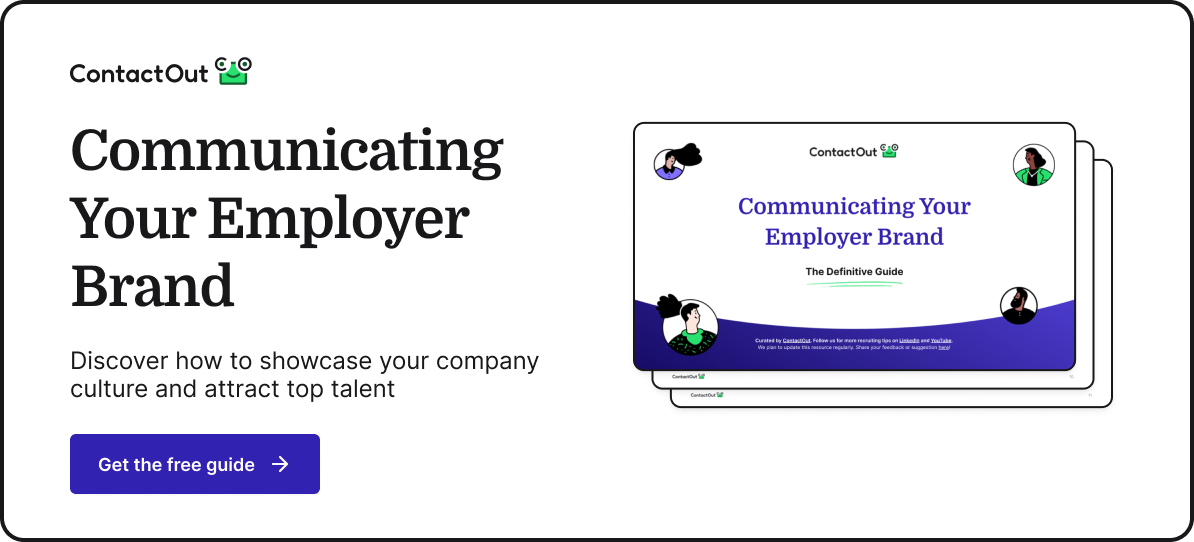🤔 What is this lesson about?
This lesson is about understanding and effectively communicating your employer brand to attract and retain top talent.
🎓 What will you learn by the end of this guide?
- The significance of employer branding.
- Detailed steps to create and communicate a compelling employer brand.
- In-depth examples of successful employer branding.
- Resources to further enhance your employer branding strategy.
🚀 Why is it important?
An employer brand represents a company’s reputation as a place to work. It’s not just about the tangible benefits but encompasses the overall employee experience, the company’s values, culture, and the narratives shared both internally and externally. In essence, it answers the question: “Why would a talented individual want to work here?”
Now, let’s explore its significance:
1. Talent Attraction:
In today’s competitive job market, top talent has the luxury of choice. A strong employer brand can make your company stand out and become the employer of choice for high-caliber candidates.
2. Reduced Hiring Costs:
Companies with strong employer brands often see a reduction in hiring costs. This is because they don’t need to rely as heavily on external recruiting agencies, and their strong reputation can lead to more direct applications.
3. Increased Employee Retention:
A clear and positive employer brand helps ensure that employees know what to expect when they join a company. When their experiences align with the brand’s promises, they’re more likely to stay long-term.
4. Enhanced Company Reputation:
In the age of social media and platforms like Glassdoor, a company’s reputation can spread quickly. A strong employer brand can lead to positive reviews and word-of-mouth recommendations, further enhancing the company’s overall reputation.
5. Higher Employee Engagement:
Employees who resonate with the company’s brand are more likely to be engaged, motivated, and committed to the company’s success.
6. Alignment with Company Values:
A well-defined employer brand helps ensure that the employees you attract and retain align with your company’s values and culture, leading to a more cohesive and harmonious workplace.
7. Economic Benefits:
A strong employer brand can lead to financial gains. Reduced turnover means fewer costs associated with hiring and training new employees. Additionally, engaged employees often lead to increased productivity and, consequently, profitability.
8. Crisis Management:
In times of crisis or negative publicity, a strong employer brand can act as a buffer. If the public and employees trust the company due to its consistent positive branding, they’re more likely to give the benefit of the doubt during challenging times.
🛠️ Here’s the step by step to do it:
1. Understand Your Unique Value Proposition:
- Identify what sets your company apart from competitors.
- Reflect on your company’s mission, values, vision, and culture.
- Engage with employees to understand what they value most about working for your company.
2. Conduct an Employer Brand Audit:
- Distribute internal surveys to gauge employee satisfaction and perceptions.
- Monitor career sites like Glassdoor for reviews.
- Analyze social media mentions and feedback about your company.
3. Craft an Employer Value Proposition (EVP):
- Define the mutual promise between the company and its employees.
- Highlight unique benefits, growth opportunities, and the company culture.
- Ensure it resonates with both current employees and potential candidates.
4. Leverage Current Employees:
- Encourage employees to share their positive experiences on social media.
- Highlight employee success stories on the company website.
- Organize employee referral programs.
5. Prioritize Onboarding:
- Design a comprehensive onboarding program that introduces new hires to the company culture.
- Ensure new employees have the resources and support they need from day one.
- Gather feedback to continuously improve the onboarding process.
6. Offer Learning Opportunities:
- Provide workshops, courses, and training sessions.
- Encourage employees to attend conferences and industry events.
- Offer mentorship programs for career growth.
7. Utilize Multimedia:
- Create engaging videos that showcase company culture and events.
- Write blog posts highlighting company achievements and employee stories.
- Share photos from company events and team-building activities.
8. Promote Diversity & Inclusion:
- Implement policies that promote a diverse and inclusive workplace.
- Organize events and workshops that celebrate diversity.
- Highlight diversity in company communications and branding.
9. Be Transparent and Genuine:
- Foster open communication channels within the company.
- Address negative feedback constructively and make necessary improvements.
- Ensure all communications, both internal and external, are authentic.
🌟 Here’s an example of it:
Starbucks stands out as a beacon of effective employer branding.

- Unique Value Proposition: Starbucks refers to its employees as “partners”, emphasizing a sense of belonging and mutual respect.
- Employer Brand Audit: They actively engage with feedback on platforms like Glassdoor and respond to reviews, both positive and negative.
- EVP: Their commitment to employee growth, benefits, and community involvement is clear in their communications.
- Leveraging Employees: Starbucks has dedicated social media accounts, such as @StarbucksJobs, where they share employee stories and interact with potential candidates.
- Onboarding: New “partners” are introduced to the Starbucks culture and values from day one, ensuring they feel integrated into the community.
- Learning Opportunities: Starbucks offers its employees opportunities for growth, including leadership training and even support for higher education.
- Multimedia Use: Their social media platforms showcase employee stories, community involvement, and company values.
- Diversity & Inclusion: Starbucks is known for its initiatives promoting diversity, from their hiring practices to their advertising campaigns.
- Transparency: The company has been open about its goals, challenges, and the steps it’s taking to address issues, fostering trust among its employees and the public.
Check out Starbucks Career Website to find out more.
🚀 Next steps:
1. Engage with Leadership:
- Why? Leadership buy-in is crucial for the success of any employer branding initiative. Their support can provide the necessary resources and drive the cultural shift.
- How?
- Present Data: Show leadership the tangible benefits of a strong employer brand, such as reduced turnover rates and higher-quality applicants.
- Share Vision: Clearly articulate the long-term vision of your employer branding strategy and how it aligns with the company’s overall goals.
- Regular Check-ins: Schedule periodic meetings with leadership to update them on progress, successes, and areas of improvement.
2. Regularly Update Your Strategy:
- Why? The job market, company goals, and employee preferences are dynamic. Your employer branding strategy should adapt to these changes.
- How?
- Feedback Loops: Regularly gather feedback from employees, new hires, and even candidates who didn’t accept your job offer. Their insights can provide valuable information on how your brand is perceived.
- Stay Updated: Keep an eye on industry trends, competitor strategies, and changes in the job market to ensure your strategy remains relevant.
- Annual Reviews: Dedicate time annually to review and adjust your employer branding strategy based on the data and feedback collected.
- On navigating the ever changing landscape of recruitment & employer branding:

3. Measure & Iterate:
- Why? Without measurement, you won’t know if your efforts are effective or where improvements are needed.
- How?
- Key Performance Indicators (KPIs): Define clear KPIs such as employee retention rates, time to hire, quality of hire, and employee engagement scores.
- Surveys: Conduct regular employee satisfaction surveys to gauge the effectiveness of your employer branding initiatives.
- Feedback Analysis: Use platforms like Glassdoor and Indeed to monitor feedback about your company. Look for patterns and areas of concern.
- Iterate: Based on the data, refine your strategies. If something isn’t working, don’t be afraid to pivot or try new approaches.
- Here’s an example of what key metrics you can use to track your employer branding:

📚 Further resources:
- Employer Branding Toolkit
- 9 Steps to Build a Successful Employer Branding Strategy
- Make Your Employer Brand Stand Out in the Talent Marketplace
- HubSpot’s Guide on Employer Branding
👋 Your employer brand is a reflection of your company’s values, culture, and the experiences you offer. With dedication and strategy, you can create a brand that resonates with top talent and helps you build a dream team. 💪🌟














